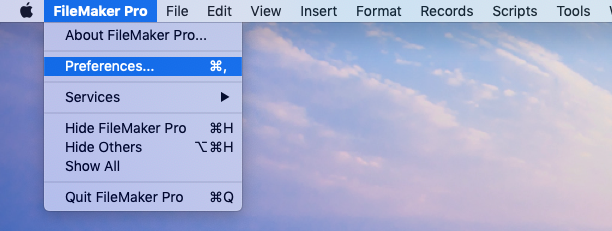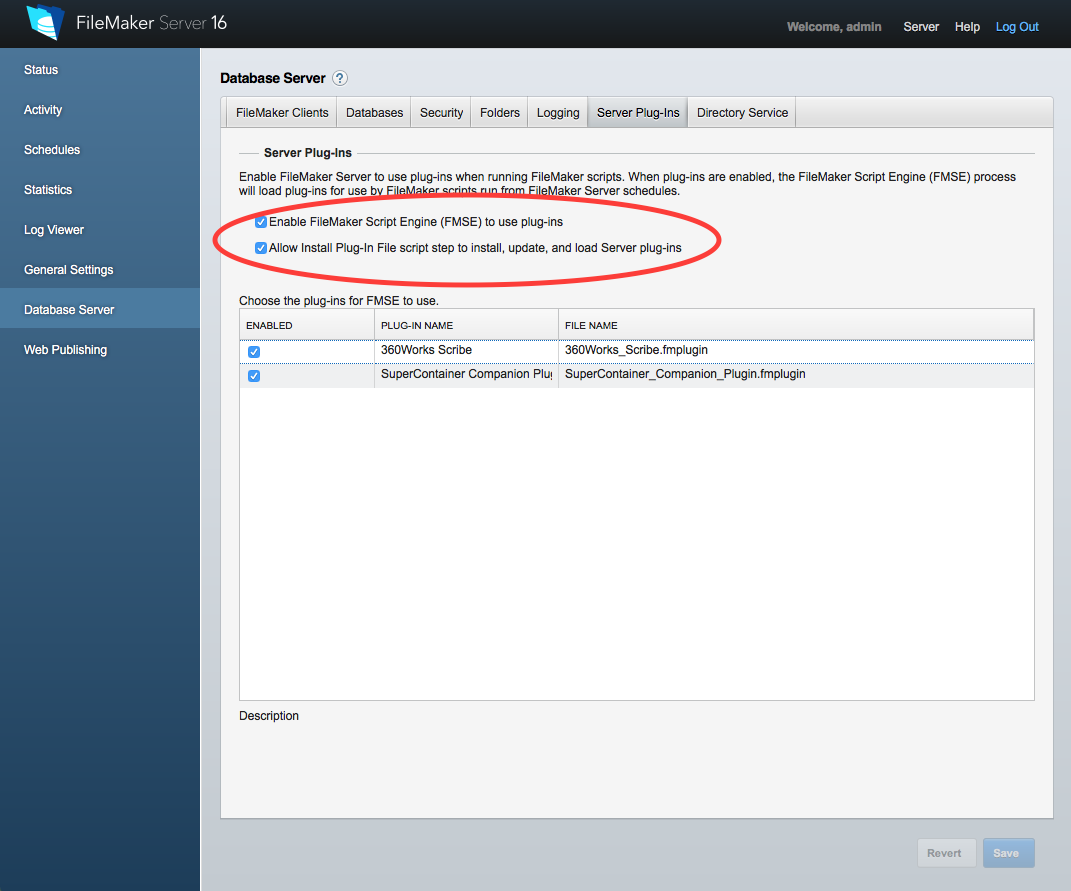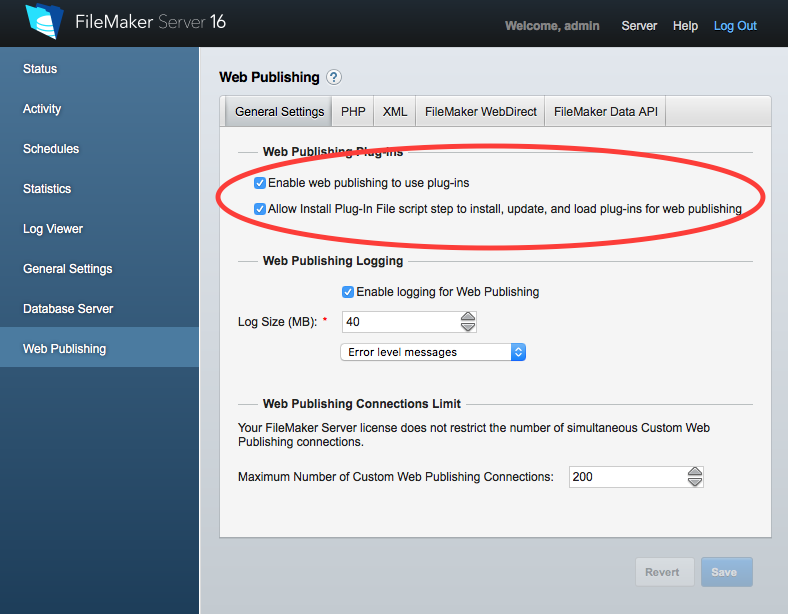Difference between revisions of "Plug-In Installation"
| Line 5: | Line 5: | ||
As long as your system meets the recommended minimum requirements set by FileMaker then you meet the requirements to use 360Works Plugins | As long as your system meets the recommended minimum requirements set by FileMaker then you meet the requirements to use 360Works Plugins | ||
| − | == | + | ==Installation== |
| + | The first step is to determine where to install the plugin. | ||
| + | |||
| + | <b>For FileMaker Pro:</b> | ||
| + | If you are a FileMaker Pro user and your database is not hosted on FileMaker Server (i.e. it is saved on your computer's hard drive) then you will need to install the plugin for FileMaker Pro. If your database is hosted on FileMaker Server, you may still need to install the plugin for FileMaker Pro. The determining factor is if your database uses the FileMaker script step "Perform Script on Server" to run the scripts that call plugin functions. If you are unsure, you can either contact your database administrator or go ahead and install the plugin for FileMaker Pro. | ||
| + | |||
| + | <b>For FileMaker Server:</b> | ||
| + | If your database utilizes the "Perform Script on Server" script step to run scripts that call plugin functions or if you intend to use the plugin in a scheduled script, you will need to install the plugin for FileMaker Server | ||
| + | |||
| + | <b>For Web Direct:</b> | ||
| + | If users will be accessing the database through Web Direct and the database does not use the "Perform Script on Server" script step to run scripts that call plugin functions then the plugin needs to be installed into the FileMaker Server Web Publishing Engine. | ||
| + | |||
| + | ===FileMaker Pro Installation=== | ||
| + | <b>Step 1:</b> Unzip the downloaded .zip file. Leave this Finder(Mac) or File Explorer(Windows) window open | ||
| + | |||
| + | <b>Step 2:</b> Open FileMaker Pro | ||
| + | |||
| + | <b>Step 3:</b> Open FileMaker Pro Preferences.<br> | ||
| + | |||
| + | On Mac this is under the FileMaker Pro menu.<br> | ||
| + | |||
| + | [[File: MacPref.png | 500px]]<br> | ||
| + | |||
| + | On Windows this is in the Edit Menu<br> | ||
| + | |||
| + | [[File: WinPref.png | 400px]]<br> | ||
| + | <br> | ||
| + | <b>Step 4:</b> In the Preferences window, click on the plugin tab and then click on the button that says "Reveal plug-in folder". This will open another Finder(Mac) or File Explorer(Windows) to the FileMaker Pro installation location<br> | ||
| + | [[File:FMPreferences.png | 500px]]<br> | ||
| + | <br> | ||
| + | <b>Step 5</b> On the window from Step 1 navigate into the folder that corresponds with your operating system. If you are using a Mac go into the "MAC" folder, a Windows go into the "WIN" folder | ||
| + | For Mac: Copy/paste or drag/drop the .fmplugin file that is inside the MAC folder into the folder that was opened in Step 4 | ||
| + | For Windows: There will be two files inside the WIN folder. The file that has the extension of .fmx is 32-bit. The file that has the extension .fmx64 is 64-bit. If you do not see the file extensions, right click on the file and select Properties. The extension will be shown next to "Type of File". Once you have determined the correct file copy/paste or drag/drop it into the folder that was opened in Step 4.</b> | ||
| + | <b>Step 6</b> Restart FileMaker Pro<br> | ||
| + | <b<Step 7</b> Check to make sure that the plugin is installed and enabled. You can do so by opening FileMaker Preferences and going to the plugins tab and making sure the plugin is listed there and is checked to indicate it is enabled. See the screen shot in step 3 that shows 360Works plugins installed with a check mark to show they are enabled. If the plugin is not listed there, then it is not installed correctly. If it is listed there and not checked as enabled, try to check it to enable it. If you get an error when trying to enable it, please contact us by sending an email to support@360works.com. | ||
| + | |||
| + | |||
| + | |||
| + | |||
| + | |||
| + | |||
To manually install, place the plugin file in the proper [[Plug-In Installation Locations|location]] for the context in which you wish to use the plugin. After installing a plug-in in any location, that platform needs to be restarted. | To manually install, place the plugin file in the proper [[Plug-In Installation Locations|location]] for the context in which you wish to use the plugin. After installing a plug-in in any location, that platform needs to be restarted. | ||
Revision as of 21:04, 19 May 2021
This is a guide to installing 360Works plug-ins, though information may also apply to other FileMaker plugins. If you are using a plugin released prior to May 2017 or using FileMaker 15 or below please see this page for plugin installation instructions.
Requirements
As long as your system meets the recommended minimum requirements set by FileMaker then you meet the requirements to use 360Works Plugins
Installation
The first step is to determine where to install the plugin.
For FileMaker Pro: If you are a FileMaker Pro user and your database is not hosted on FileMaker Server (i.e. it is saved on your computer's hard drive) then you will need to install the plugin for FileMaker Pro. If your database is hosted on FileMaker Server, you may still need to install the plugin for FileMaker Pro. The determining factor is if your database uses the FileMaker script step "Perform Script on Server" to run the scripts that call plugin functions. If you are unsure, you can either contact your database administrator or go ahead and install the plugin for FileMaker Pro.
For FileMaker Server: If your database utilizes the "Perform Script on Server" script step to run scripts that call plugin functions or if you intend to use the plugin in a scheduled script, you will need to install the plugin for FileMaker Server
For Web Direct: If users will be accessing the database through Web Direct and the database does not use the "Perform Script on Server" script step to run scripts that call plugin functions then the plugin needs to be installed into the FileMaker Server Web Publishing Engine.
FileMaker Pro Installation
Step 1: Unzip the downloaded .zip file. Leave this Finder(Mac) or File Explorer(Windows) window open
Step 2: Open FileMaker Pro
Step 3: Open FileMaker Pro Preferences.
On Mac this is under the FileMaker Pro menu.
On Windows this is in the Edit Menu
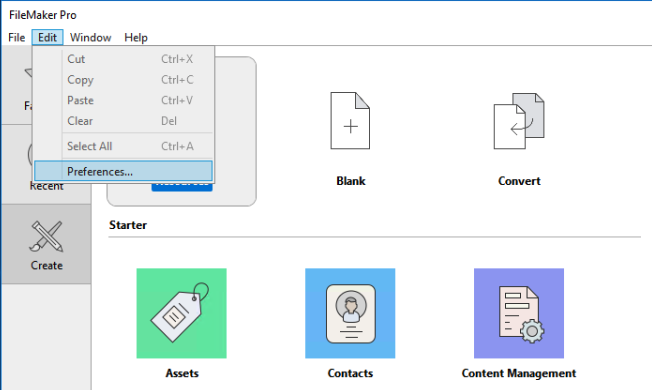
Step 4: In the Preferences window, click on the plugin tab and then click on the button that says "Reveal plug-in folder". This will open another Finder(Mac) or File Explorer(Windows) to the FileMaker Pro installation location
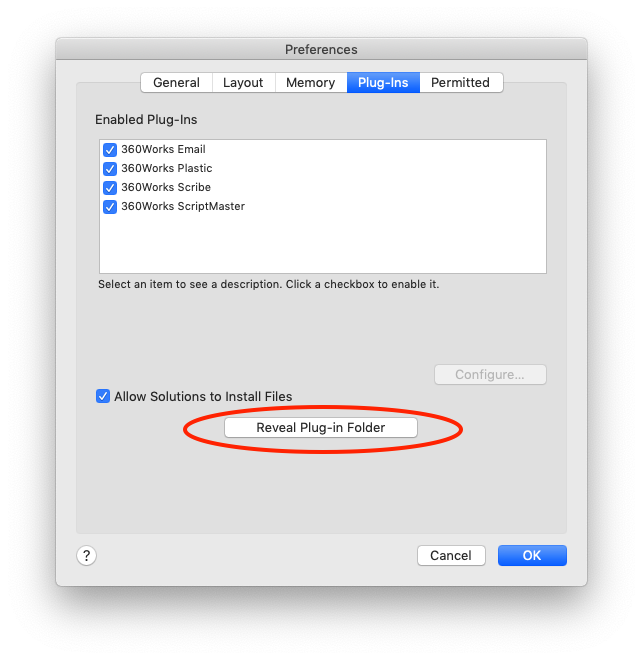
Step 5 On the window from Step 1 navigate into the folder that corresponds with your operating system. If you are using a Mac go into the "MAC" folder, a Windows go into the "WIN" folder
For Mac: Copy/paste or drag/drop the .fmplugin file that is inside the MAC folder into the folder that was opened in Step 4
For Windows: There will be two files inside the WIN folder. The file that has the extension of .fmx is 32-bit. The file that has the extension .fmx64 is 64-bit. If you do not see the file extensions, right click on the file and select Properties. The extension will be shown next to "Type of File". Once you have determined the correct file copy/paste or drag/drop it into the folder that was opened in Step 4.
Step 6 Restart FileMaker Pro
<b<Step 7 Check to make sure that the plugin is installed and enabled. You can do so by opening FileMaker Preferences and going to the plugins tab and making sure the plugin is listed there and is checked to indicate it is enabled. See the screen shot in step 3 that shows 360Works plugins installed with a check mark to show they are enabled. If the plugin is not listed there, then it is not installed correctly. If it is listed there and not checked as enabled, try to check it to enable it. If you get an error when trying to enable it, please contact us by sending an email to support@360works.com.
To manually install, place the plugin file in the proper location for the context in which you wish to use the plugin. After installing a plug-in in any location, that platform needs to be restarted.
- For FileMaker Pro, just restart the application.
- For FileMaker Server, restart the FileMaker Script Engine using the fmsadmin tool.
- For FMS Web Publishing Engine, restart the WPE itself, either through the Admin Console or the fmsadmin tool. Note that only plug-ins installed in the script engine will show up in the Admin Console; plug-ins installed in Web Publishing will not.
For FileMaker Server and Web Publishing Engine, you must enable the option to allow plug-ins. See screenshots below.
Installation via Script
In FileMaker 12+, you can install and update plug-ins from container fields using the Install Plug-In File script step. Simply insert the plug-in into a container field, and call a script including that script step. This makes it possible to deploy your solution with a plug-in bundled in that installs and registers itself with a script. You can then call the function Get (InstalledFMPlugins) to see the display name, version, and state. This script step will install plug-ins in the location associated with the context the script is run in. Our AutoUpdate file (see below) uses this method for FileMaker 12+.
For FileMaker Server and FileMaker Cloud 1 - you will need to host the solution described above on your server and then call the script that installs the plugin via the Perform Script on Server script step. It is important to call the script with the PSOS script step else the plugin will install locally in FileMaker Pro.
If you are using your plug-in to run server-side scripts (either with 'Perform Script on Server' or with scheduled scripts) with FileMaker Server, then you will need to enable the FileMaker Script Engine (FMSE) to allow the use and installation of plug-ins, as show in this screen shot:
The same applies to using plug-ins with the Web Publishing Engine, either for Web Direct or Custom Web Publishing.
AutoUpdate
We also offer an AutoUpdate file to help install or update any of our plug-ins. For more information on the process, open the database at fmnet:/autoupdate.360works.com/AutoUpdate360Works
